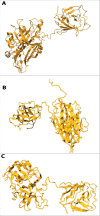Genotype-specific acquisition, evolution and adaptation of characteristic mutations in hepatitis E virus
- PMID: 28727933
- PMCID: PMC5955438
- DOI: 10.1080/21505594.2017.1358349
Genotype-specific acquisition, evolution and adaptation of characteristic mutations in hepatitis E virus
Abstract
Hepatitis E virus (HEV) infection is a major cause of acute hepatitis but also provokes chronic infection in immunocompromised patients. Although the pathogenesis and treatment outcome involve complex interplay between the virus and host, the nature of adaptive responses of HEV to the host immune system remain obscure at best. In this study, we used large-scale proteomic bioinformatics to profile characteristic mutations in human HEV isolates associated to ribavirin treatment failure, chronic hepatitis, hepatic failure or altered immunoreactivity. The prevalence of specific mutations was examined in a large number of protein sequences of ORF1 and ORF2 regions of the 3 major human-derived HEV genotypes (1, 3 and 4). By analyzing potential B, CD4+ and CD8+ T cell epitopes, we found that many of these mutations overlap with the predicted epitopes and are frequently present among the 3 HEV genotypes. These overlapping mutations mediate reduced antigenicity. Finally, by delineation of diversification and evolution of the underlying epitopes, we observe that most of these variants apparently evolved earlier in genotype 1 when compared with genotypes 3 and 4. These results indicate that HEV is under substantial evolutionary pressure to develop mutations enabling evasion of the host immune response and resistance to antiviral treatment. This indicates the existence of an ongoing evolutionary arms race between human immunity, antiviral medication and HEV.
Keywords: B and T cells; epitope; evolution; hepatitis E virus; mutation.
Figures






Comment in
-
Capturing virus evolution by proteomic bioinformatics: Hunting for characteristic mutations in the hepatitis E virus genome.Virulence. 2018 Jan 1;9(1):13-16. doi: 10.1080/21505594.2017.1384526. Epub 2017 Nov 10. Virulence. 2018. PMID: 28945510 Free PMC article. No abstract available.
References
-
- Kamar N, Bendall R, Legrand-Abravanel F, Xia NS, Ijaz S, Izopet J, Dalton HR. Hepatitis E. Lancet. 2012; 379:2477-88. https://doi.org/10.1016/S0140-6736(11)61849-7. PMID:22549046 - DOI - PubMed
-
- Lozano R, Naghavi M, Foreman K, Lim S, Shibuya K, Aboyans V, Abraham J, Adair T, Aggarwal R, Ahn SY, et al.. Global and regional mortality from 235 causes of death for 20 age groups in 1990 and 2010: A systematic analysis for the Global Burden of Disease Study 2010. Lancet. 2012;380:2095-128. https://doi.org/10.1016/S0140-6736(12)61728-0. PMID:23245604 - DOI - PMC - PubMed
-
- Teshale EH, Hu DJ. Hepatitis E: Epidemiology and prevention. World J Hepatol. 2011;3:285-91. https://doi.org/10.4254/wjh.v3.i12.285. PMID:22216368 - DOI - PMC - PubMed
-
- Hakim MS, Wang W, Bramer WM, Geng J, Huang F, de Man RA, Peppelenbosch MP, Pan Q. The global burden of hepatitis E outbreaks: A systematic review. Liver Int. 2017;37:19-31. https://doi.org/10.1111/liv.13237. PMID:27542764 - DOI - PubMed
-
- Kamar N, Mallet V, Izopet J. Ribavirin for chronic hepatitis E virus infection. N Engl J Med. 2014;370:2447-8. https://doi.org/10.1056/NEJMoa1215246. PMID:24941183 - DOI - PubMed
Publication types
MeSH terms
Substances
LinkOut - more resources
Full Text Sources
Other Literature Sources
Research Materials
